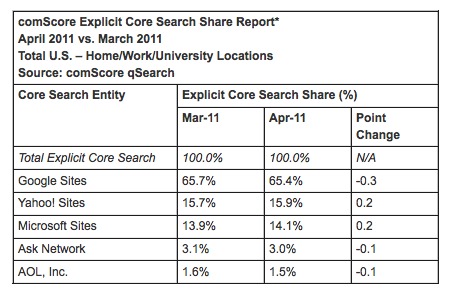Google announced via its new official Search Blog that it is rolling out Social Search around the globe. This comes just days after Bing upped the ante in the social search game by integrating Facebook data in much more elaborate ways. Google’s social search, however, may prove useful in some cases, but you may see more content from strangers than you do from your real friends.
Does Google’s Social Search make results less relevant? Comment here.
Google has been doing social search since 2009, and earlier this year it was updated to be more useful, with social results appearing throughout the SERP, as opposed to just in a cluster at the bottom of the SERP. Google says they’re mixed in based on relevance.
“For example, if you’re looking for information about low-light photography and your friend Marcin has written a blog post about it, that post may show up higher in your results with a clear annotation and picture of Marcin,” says Google software engineer Yohann Coppel.
“Social Search can help you find pages your friends have created, and it can also help you find links your contacts have shared on Twitter and other sites. If someone you’re connected to has publicly shared a link, we may show that link in your results with a clear annotation,” says Coppel. “So, if you’re looking for information about modern cooking and your colleague Adam shared a link about Modernist Cuisine, you’ll see an annotation and picture of Adam under the result. That way when you see Adam in the office, you’ll know he might be a good person to ask about his favorite modern cooking techniques.”
How Google Determines What to Show In Social Search Results
First of all, users must be logged into Google to get the benefits of social search. “If you’re signed in, Google makes a best guess about whose public content you may want to see in your results, including people from your Google Chat buddy list, your Google Contacts, the people you’re following in Google Reader and Buzz, and the networks you’ve linked from your Google profile or Google Account. For public networks like Twitter, Google finds your friends and sees who they’re publicly connected to as well,” explains Coppel.
Google deserves credit for giving users great deal of control about what people they’re using here, though they could still go further. You can go to your Google Dashboard, find the Social Circle and Content section, and edit accordingly. If you go to the “view social circle link” you can see every single person listed by:
- Direct connections from your Google Chat buddies and contacts. It even shows you which of these people have content and which don’t. For the ones that do, it shows you which sites they have content on.
One important thing to note: it actually does include Facebook Page content. For example, I’m connected to Danny Sullivan in my social circle, for example, and Google will show me updates from his Facebook page, as he has it linked to his Google Profile. What’s missing, however, is your personal Facebook network of friends (which in my opinion is the most valuable social data there currently is on the web, if you’re a Facebook user).
- Direct connections from links through Google Profiles or Connected Accounts “For example, if you listed your Twitter account on your profile or if your Twitter posts appear in your public Buzz stream, then relevant content from people you follow on Twitter will show up in your search results,” Google explains in that section. “You can change these relationships by visiting the corresponding services and adding or removing connections.”
- Secondary connections that are publicly associated with your direct connections. In other words – friends of friends (at least public friends of friends). There is a little less control here, unfortunately. You can’t remove these people from your social circle unless you remove the friend that’s connecting you to them.
To me, this actually seems like a step backwards in relevancy of social search. You’re probably a lot less likely to care about what someone thinks just because they know someone you know, than you are if you actually know them. A lot of people don’t even care about what the people they actually do know think.
Naturally, this is the biggest list and potential source of material for Google to draw from, making it more likely that you see results from people you don’t know than people you do.
A cool thing about the entire list is that you can click “show paths” next to any name that has content, and it will show you exactly how you’re connected. You can be linked to someone via Twitter, and if that person links their Twitter account to their Quora account, you might see their Quora content too. If that Quora account links to their Facebook account, you might see stuff from their Facebook account if you have permission to see that content (which if set to public or if you’re Facebook friends, you should be able to see it).
Where are my friends?
I notice one gaping hole in Google’s social search strategy besides the lack of comprehensive Facebook integration (though it’s certainly connected to that). That would be the lack of a substantial amount of my actual closest friends. I can only assume that many users have a similar issue.
That’s exactly why Bing’s Facebook integration is a very important factor in its competition with Google. Bing, unlike Google, does tap into your actual Facebook friends for search relevancy (though there is plenty of room for improvement on Bing’s part as well). The Wajam browser extension is still currently a better solution to the problem, if yo ask me. It will add your Facebook and Twitter friends to your results on both Google and Bing.
It is also for this reason (at least partially) that Google is competing more directly with Facebook now in social. Google wants users to develop the kinds of relationships among friends that people currently have on Facebook, on Google’s own network (which runs throughout various products, but ultimately the Google account, which is at the center of nearly everything – Gmail, YouTube, Buzz, Docs, Chrome OS, etc. The list goes on.
As long as Google and Facebook aren’t going to play nice together, Google needs to succeed in social to have the best search relevancy in the social part of search. And that part of search is clearly becoming more and more important. That’s simply one competitive advantage Bing has over Google right now. It’s also why Facebook itself is a threat to Google search in some ways.
It will be very interesting to see how far Google takes social search over time. We know Google is currently working on increasing its presence as a force in social, and the upcoming +1 button should play a significant part in that. As search gets more social, however, it presents new challenges for search engine optimization, and perhaps less significance on algorithm updates (like Panda) from the webmaster point of view.
Social can not only be a signal of relevance on a personalized level, but if content is shared a lot, it can also be seen as a signal of quality, because people don’t share content that sucks, unless they’re doing it as a joke or using it as an example of what not to do (like I said, it’s just a “signal”). This is nothing new, but it shows the importance of diversifying your traffic sources.
If you rely heavily on search, as many of the big victims of the Panda update have, you will always be at the mercy of the search engines. If you can find ways to get more love from social networks and links from others, it’s bound to help you in search as well.
Is Google’s social search helpful or does it miss the mark? Tell us what you think.



























